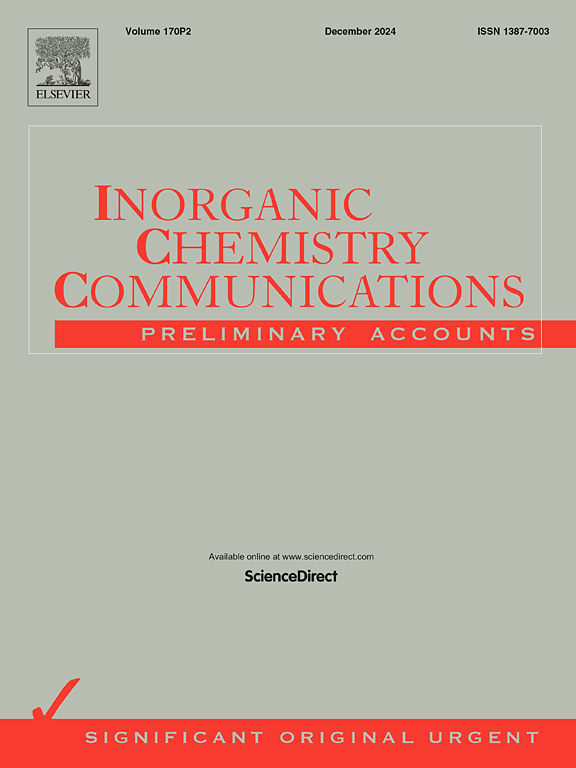Efficient electrochemical determination of Sudan I in food samples based on modified electrode by using Ni-Fe layered double hydroxide nanosheets and ionic liquid
IF 4.4
3区 化学
Q1 CHEMISTRY, INORGANIC & NUCLEAR
引用次数: 0
Abstract
Sudan I, is one of the commonly used azo dyes in food samples, which has shown adverse effects on human health. Therefore, determining the level of Sudan I in food samples can be very effective in ensuring food safety and protecting human health. In this study, an electrochemical sensing platform was designed using Ni-Fe layered double hydroxide nanosheets and ionic liquid modified carbon paste electrode (Ni-Fe LDH/ILCPE) which was utilized to determine Sudan I. Comparison of cyclic voltammograms of Sudan I on the unmodified CPE and Ni-Fe LDH/ILCPE showed that, the higher oxidation currents were obtained on the surface of the Ni-Fe LDH/ILCPE, indicating that the modified CPE owns significant surface improvement effects and good electrochemical performance in detecting Sudan I. Under optimized conditions, the developed Ni-Fe LDH/ILCPE sensor demonstrated a linear relationship between the voltammetric response and Sudan I concentrations from 0.03 µM to 510.0 µM with a low detection limit (LOD) of 0.01 µM based on S/N = 3.0. Additionally, the Ni-Fe LDH/ILCPE platform exhibits high accuracy, with a recovery of 96.4 % to 104.1 % for Sudan I determination in food samples including Ketchup and Chilli powder, which implies that it will be a potential detection method for Sudan I detection.

使用 Ni-Fe 层状双氢氧化物纳米片和离子液体改性电极高效电化学测定食品样品中的苏丹 I
苏丹 I 是食品样本中常用的偶氮染料之一,对人体健康有不良影响。因此,检测食品样品中苏丹 I 的含量可以有效确保食品安全,保护人类健康。本研究利用 Ni-Fe 双层氢氧化物纳米片和离子液体修饰碳浆电极(Ni-Fe LDH/ILCPE)设计了一种电化学传感平台,用于测定苏丹 I。比较苏丹 I 在未改性 CPE 和 Ni-Fe LDH/ILCPE 上的循环伏安图发现,Ni-Fe LDH/ILCPE 表面的氧化电流更大,这表明改性 CPE 具有显著的表面改良效果和良好的电化学性能来检测苏丹 I。在优化条件下,所开发的 Ni-Fe LDH/ILCPE 传感器的伏安响应与苏丹 I 的浓度在 0.03 µM 至 510.0 µM 之间呈线性关系,基于信噪比 = 3.0 的低检测限 (LOD) 为 0.01 µM。此外,Ni-Fe LDH/ILCPE 平台的准确度也很高,在测定番茄酱和辣椒粉等食品样品中的苏丹 I 时,回收率在 96.4 % 到 104.1 % 之间,这意味着它将成为一种潜在的苏丹 I 检测方法。
本文章由计算机程序翻译,如有差异,请以英文原文为准。
求助全文
约1分钟内获得全文
求助全文
来源期刊

Inorganic Chemistry Communications
化学-无机化学与核化学
CiteScore
5.50
自引率
7.90%
发文量
1013
审稿时长
53 days
期刊介绍:
Launched in January 1998, Inorganic Chemistry Communications is an international journal dedicated to the rapid publication of short communications in the major areas of inorganic, organometallic and supramolecular chemistry. Topics include synthetic and reaction chemistry, kinetics and mechanisms of reactions, bioinorganic chemistry, photochemistry and the use of metal and organometallic compounds in stoichiometric and catalytic synthesis or organic compounds.
 求助内容:
求助内容: 应助结果提醒方式:
应助结果提醒方式:


